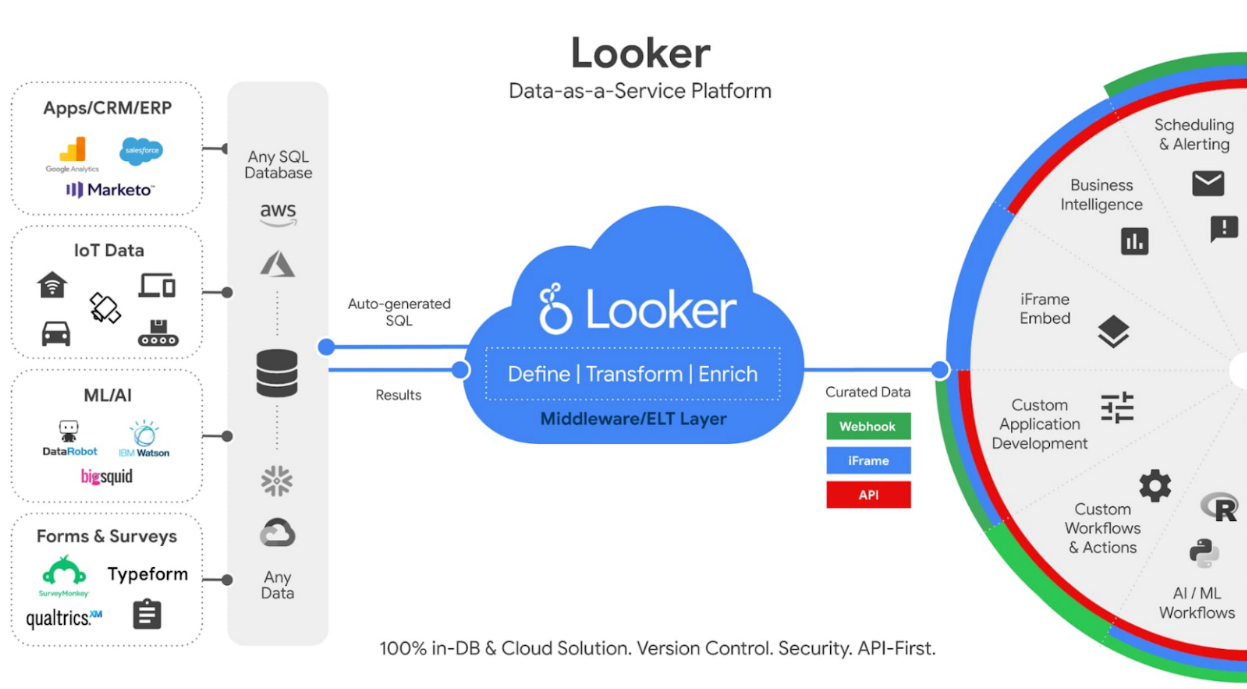Google Cloud Looker. The Best Analytics Platform to Win with Data
In this brief article, we want to mention the fundamental differentiators of Looker.
Looker is database manager independent
Being \"database agnostic\", Looker is capable of working with a large number of data repositories, in the cloud or on private infrastructure. This allows Looker to adapt to the changing needs and technologies in the data analysis area.
Semantic Layer
Looker's use of a semantic layer in the data modeling and consumption process solves many traditional data analytics problems. Firstly, you don't have to develop the data model from scratch, as most of the code is automatically generated by Looker. Additionally, the model and query speed are not limited to the database used, as Looker employs a caching policy (in-memory storage) to speed up execution. The semantic layer allows adding additional tables to model information outside the database manager, turning Looker into an ETL tool. This modeling, implemented strategically, can significantly speed up the responses of our analyses.
Version Control, CI/CD, and System Activity Model
Version control in Looker uses Git repositories to track and manage changes in LookML code and other resources such as dashboards. This allows traceability of who did what in Looker, and the ability to revert to previous versions of dashboards. Working with versioned code makes it possible to use techniques usually limited to software development, such as Continuous Integration / Continuous Deployment (CI/CD) and enabling a development workflow with development, testing, and production environments.
Disaster recovery in Google Cloud and Looker is based on backup strategies, high availability, data replication, and recovery plans to ensure the integrity and availability of data and resources. Monitoring and alerts to detect problems before they become disasters are key in this strategy. Looker provides a System Activity model where all information about users, instance performance, connections, data usage, alerts, and more is stored. These combined practices ensure effective version control and solid preparation for unexpected events.
Data Monetization
Data monetization refers to the practice of generating value from the data that is stored and managed. Looker, being not only a business intelligence tool but a data platform, is uniquely positioned to enhance data monetization.
Looker allows creating custom dashboards and reports that offer valuable information to clients or business partners. These dashboards can be embedded in commercial or internal applications. Furthermore, Looker allows access and consumption of the semantic layer and modeled data, not only through embedded reports but also through a powerful API and numerous SDKs in the most popular programming languages. The limit of users who can consume this content depends on the performance of the Looker instance and not on the number of purchased licenses, unlike other well-known BI platforms. This makes Looker economical in scenarios with high user volumes.
Conclusion
This article is part of a series where we will delve deeper into the advantages of adopting Looker as part of an enterprise data platform, as well as some technological challenges that its successful implementation entails. I hope you enjoyed this brief introduction to Looker's main differentiators. If you are a Looker enthusiast, or would like to learn more about this incredible platform, don't hesitate to contact us!

